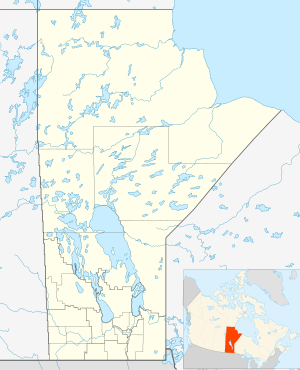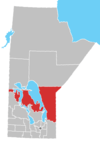Fort Alexander, Manitoba
| Fort Alexander, Manitoba Sagkeeng - Mouth of the river[1]:14 | |
|---|---|
| Coordinates: 50°36′32″N 96°17′44″W / 50.60889°N 96.29556°W | |
| Country |
|
| Time zone | [[UTCUTC−6]] (GMT) |
| • Summer (DST) | DST |
Fort Alexander (also known as Sagkeeng in Ojibway, meaning mouth of the river)[1]:14 is a community in Manitoba, Canada, located on the Sagkeeng First Nation, on the south bank of the Winnipeg River. The Sagkeeng area at the mouth of the Winnipeg River, was originally settled with native camps used for fishing, hunting, and trade.
During the fur trade era, La Vérendrye built a trading post, named Fort Maurepas, on the north side of the river; this post was abandoned near the end of the French colonial period. In the year 1792, a clerk for the British North West Company, Toussaint Lesieur, built a post on the south side. It became an important provisioning post for the canoe brigades. Bags of pemmican, brought from the North West Company's posts on the upper Assiniboine River, were stored here and taken as needed by the canoe brigades passing between Grand Portage (later, Fort William) and the far northwest. This post was usually referred to as Fort Bas de la Rivière, because of its location at the "bottom" or mouth of the Winnipeg River, and it seems to have functioned as the capital of the Company's Lake Winnipeg district.
The Hudson's Bay Company operated its own post here for a few years between 1795 and 1801. In 1807, the North West Company partner Alexander MacKay rebuilt the post on a nearby site. Beginning in 1808, the new post was known as Fort Alexander. Since the big game of the area had been hunted out by the late 1700s, fish, grains and garden vegetables were the staple foods of the area. By 1812 the Bas de la Rivière gardens were selling vegetables to the incoming Red River Settlers. By 1817 the Metis staff of the Northwest Company was farming wheat, barley, peas, oats and potatoes at this location and were supplying the Red River Settlement with seed grain. In 1815 a horse-powered flour mill was built. [2]. After the Northwest and Hudson's Bay companies merged in 1821, Fort Alexander continued to be operated as a trading post for the natives in the region.
This ancient trading area for native peoples was a part of the copper culture as well. Copper points and artifacts were found in the area. The source of the copper was likely from the Lake Superior copper mines that are thousands of years old.
Today, the Fort Alexander First Nation is known as the Sagkeeng First Nation. It is located near the town of Pine Falls, Manitoba. Members of the Sagkeeng First Nation are Ojibway, or otherwise known as Chippewa, and part of the larger group of Anishinaabe peoples.[1]
Recently of note is dance group Sagkeeng's Finest, winners of the first season of Canada's Got Talent.[3][4][5]
References
- 1 2 3 4 "Traditional First Nation community names" (PDF), Manitoba First Nations Education Resource Centre Inc., Principal's Newsletter, February 2009, retrieved July 15, 2016
- ↑ Barkwell, Lawrence J. (2018) Historic Metis settlements in Manitoba and geographical place names. Winnipeg, Manitoba: Louis Riel Institute, 2018. ISBN: 978-1-927531-1-81
- ↑ "" 'Canada's Got Talent' Recap: Sakgeeng's Finest Wins", The Star
- ↑ "Sakgeeng's Finest get ready for prime time", Winnipeg Free Press
- ↑
External links
Coordinates: 50°36′32″N 96°17′44″W / 50.60889°N 96.29556°W

